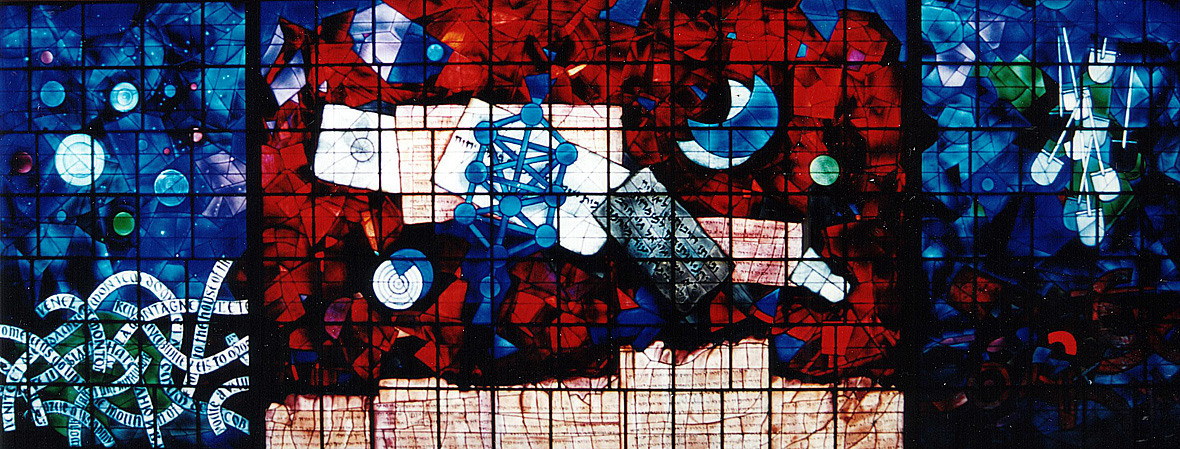2.4.5 Summary
Charismatic synagogal type ℸ (daleth) groups' physical arrangements compare in large to those of type ℷ (gimel) groups and orthodox synagogues. Here also the obvious differences to orthodox synagogues exist. The most obvious differences are that men and women sit together in worship services, and the use of the New Testament. The obvious difference to type ℷ (gimel) congregations is the presence of a dance floor. Type ℸ (daleth) congregations show the shema calligraphy at the front of the worship room. Ritual artefacts for Sabbath and other Jewish holidays are used. Male believers can use skull cap, prayer shawl and phylactery.
The Interaction with the Supernatural within charismatic synagogal type groups remains revelatory also after initial experience or conversion. Supernatural experience triggers not only conversion. It can also become a programme for social action beyond the borders of the own group. Also, it seems to rather initiate social engagement than intellectual efforts. The exploratory mode of religious construction interprets supernatural experience and appears to interact with the supernatural. Supernatural revelatory experiences are aspired and appraised in private devotion and public worship. That synagogal services are since long carefully prescribed and regulated by Siddur and Jewish tradition seems not to hamper supernatural experience of a charismatic kind.
The internal social structure of charismatic synagogal type ℸ (daleth) groups appears hierarchical. Founders are religious specialists, first by their inspiring supernatural experience, second by their knowledge of Scripture and religious Jewishness. The relationship between religious specialists and laity appears warm and caring in both directions, creating an inclusive atmosphere that appears to balance the official hierarchy. The openness for expression of supernatural experiences requires the specialists occasionally to interfere and correct, and the laity to accept such. The traditional participation of members in the synagogal service requires the leadership to know the life situations of its members.
As in the other three congregational types, women are not welcome to teach in public, to read from the Torah, except in home meetings. They participate in prayer, singing and dance in the synagogue. Women develop activities in less formal meetings, privately and in charity. The social interaction with other groups depends on the role charismatic exercise and synagogal praxis plays there. The groups appear partially to depend on finances and help from foreign Messianic organizations and Christian groups. As already noted with type ℷ (gimel), ecclesiastic leaders appear considerably reserved regarding the synagogal-rabbinical expression.
The mode of religious construction of the external social interaction with Christian bodies appears cooperating at large. Criticism of Christian prejudicing regarding the Jewish is firm, but expressed politely and gently. Messianic Jewish and Christian bodies from abroad supply moral and material backup. The relationship with Orthodox Judaism appears conflicting, shaped by fierce hostility from some ultra-Orthodox. Yet aggression from extreme sides appears to function detrimentally for the aggressors regarding the assumed purpose of assaults. Type ℸ (daleth) appears to maintain extraordinary cooperative relations with local authorities, who supply them with means for distribution among needy immigrants.

„The Ardon Windows” 1984, stained glass, 16.6 x 6 m
The Jewish National and University Library, Givat Ram campus, Jerusalem. Kalab 1995
„And many people shall go and say, Come ye, and let us go up to the mountain of the LORD, to the house of the God of Jacob; and he will teach us of his ways, and we will walk in his paths: for out of Zion shall go forth the law, and the word of the LORD from Jerusalem. And he shall judge among the nations, and shall rebuke many people: and they shall beat their swords into plowshares, and their spears into pruninghooks: nation shall not lift up sword against nation, neither shall they learn war any more.” Isaiah 2:3-4 (KJV)
Left panel: Scrolls as paths of many nations to Jerusalem; Isiah's prophecy in many languages and alphabets. Central panel: The ancient Dead Sea Qumran scroll of Isaiah as Jerusalem's wall below. Above, a piece of parchment with the words „and they shall beat their swords into ploughshares” and the blue Tree of Sefirot, the attributes of God, from the Kabbalah, and the circle within a circle from the mystical Book of Zohar. Right panel: The prophecy fulfilled, fragmented weapons have been beaten into farming implements, floating in the skies of peace. (A. Guildine ed. The Ardon Windows. The Jewish National and University Library, Givat Ram, Hamakor Jerusalem 1985.)